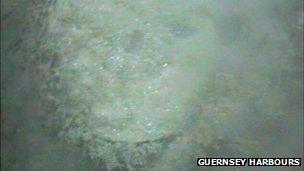World War II bomb detonated off Guernsey
- Published

Royal Navy divers moved the charge further out to sea before detonating it
A German World War II depth charge found near the entrance to Guernsey's St Peter Port Harbour has been detonated at sea.
Royal Navy divers identified the German Mark 1 depth charge and made it safe.
It was then removed and sunk on the northern tip of the Great Bank before being detonated in a controlled explosion just before 12:30 BST.
The device had to be moved as it could have damaged the harbour where it was originally found.
It was discovered last week during a routine dive on the "ammunition wreck", about 600m (1,970ft) east of the harbour.
An exclusion zone around the wreck of 200m on the surface and 500m underwater remained in place until 16:30 when the navy divers confirmed the area was safe.
Inspector Terry Coule, from the Guernsey Police bomb disposal team, said the operation had been timed to "minimise disruption to air movements".
Shockwave danger
Known locally as the "ammunition wreck" the armed trawler V209, Dr Rudolf Warhendorf, was sunk in the summer of 1944.
It was escorting a convoy to the island, which was occupied by the Germans, when it was sunk by Allied aircraft.
The guns have been removed from the trawler and one can be seen at the German Occupation Museum.
Insp Coule said of the depth charge: "It was part of the defensive stores on the boat when it was operational."
He said it was much smaller device than the one removed from Bluebell Wood in August, which had been 850lb, while this one was about 100lb.
Insp Coule said one of the navy divers removed the firing mechanism while it was on the seabed.
He said the device had to be moved due to the "danger to the infrastructure of the harbour from the ground shock or the shockwave from the weapon had it been blown up where it was".
- Published16 October 2013
- Published14 October 2013
- Published20 August 2013
- Published18 August 2013